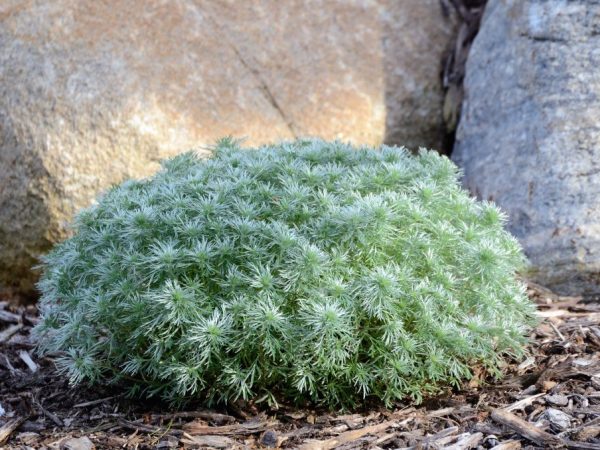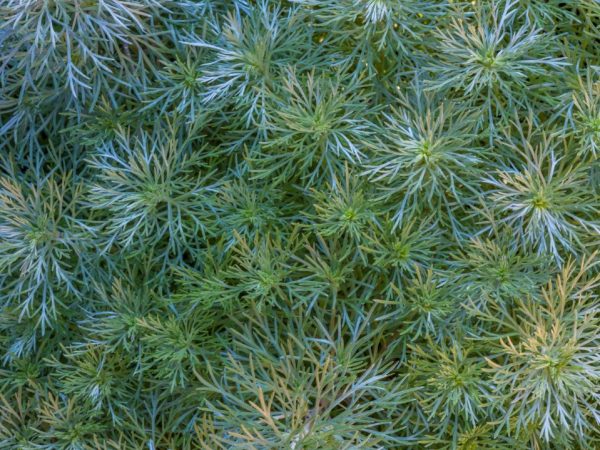Wormwood Schmidt Nana
Wormwood Schmidt Nana is an ornamental plant. It grows from early spring to late autumn. It is used in landscape design of parks and urban areas, as well as in private gardening.

Wormwood Schmidt Nana
Characteristic
Schmidt's wormwood is a type of wormwood that came from the Far Eastern region of Russia and Japan. A variety called Nana, known as the Silver mound, is used in horticultural culture. It is a small hemispherical semi-shrub with shoots growing in a vertical direction, densely covered with foliage. The leaves of Schmidt Nana wormwood are thin and narrow silky hairs of bluish or green color with a tint of silver (silvery), they are pinnately dissected, densely pubescent.
The advantage of growing the Schmidt wormwood bush in open soil is its rapid growth, which makes it possible to improve the territory in a short period of time.
Wormwood shoots form a round-shaped bush or a dense curtain growing up to 0.3 m.
The paniculate inflorescences of Schmidt's wormwood grass are located on erect peduncles, formed by small yellow or light yellow flowers. The flowering period is from August to September.
Landing place
Schmidt's wormwood is not demanding on the quality of the soil, it fully develops on poor lands, but with good looseness, and in fertile soils it loses its compactness, growing rapidly. Growing under natural conditions in semi-desert and desert, the shrub is a drought-resistant and winter-hardy plant. The selection of soil depends on the type:
- when planting the silver wormwood variety of Schmidt, peat acidic soil is not recommended, it grows well on poor, neutral soil with a well-organized drainage system;
- varieties of Nana wormwood with green foliage grow on fertile and moist soil.
For planting the silvery wormwood Nana, the best place will be the place that is well lit by the sun's rays, species with green foliage love shade.
Features of planting and care

The shrub needs pruning
In the process of planting Schmidt's wormwood, river sand is added to the planting hole, which gives the soil the looseness necessary for the shrub. Additional organic matter provides the plant with better survival rate.
Watering is rarely carried out, mainly in hot dry weather.
With increased soil moisture and frequent watering, Schmidt's wormwood Silver Mound acquires a more saturated green hue and at the same time loses its pubescence, losing its decorative attractiveness.
The wormwood bush grows in an open space with great intensity, therefore, in the process of caring for it, it is worth regularly cutting off the rhizomes. Pruning allows you to shape the shrub into a compact, fluffy pillow. Limit the growth of the bush in open soil by placing a border tape around the plant or growing in separate pots and containers.
Wormwood shoots are cut in autumn or spring.When the flower stalks cover the entire plant, the flowers are removed.
Reproduction
Schmidt's wormwood is propagated by seeds, division, root segments and cuttings. Breeding features:
- wormwood seeds are sown in warm greenhouse conditions in April, followed by diving shoots with a distance of 7-9 cm into pot containers of 1-3 pieces;
- cuttings are carried out from May to July, so that rooting occurs before the onset of the cold season, young and mature shoots 7-10 cm long are taken as cuttings;
- reproduction by division is carried out every 2-3 years to rejuvenate the plant, which begins to die off in the central part;
- root segments - reproduction by dividing the root system of a bush dug out of the ground and planting the separated parts in a new place.
The propagated shoots are temporarily planted on loose sandy soils, followed by planting in a permanent place of growth a year later. In the process of rooting, the cuttings are not shaded, they are rarely watered.
Conclusion
Ornamental wormwood of Schmidt is widely used in horticulture because of its carved silvery foliage, which, together with the yellow flowering, gives the plant composition an airiness. Undemanding to care. It grows throughout spring and summer until late autumn.


